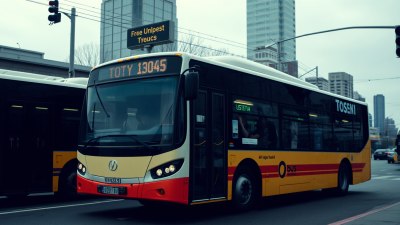No One Knows Where the Bus Is Really Going
Explore the mystery behind public transport and its unpredictability. Discover the journey beyond the destination.

Image created with Flux Schnell
Public transport often serves as the lifeblood of urban environments, ushering millions from point A to point B. Yet behind the everyday operation lies a veil of mystery: No one truly knows where the bus is really going. This notion reflects not only the unpredictability of bus routes but also the deeper philosophical contemplation of life itself. In this article, we will unravel these mysteries of public transport, examining both the practical and existential questions they raise.
The Complex Nature of Bus Routes
Every city boasts a unique public transport system with an intricate web of bus routes, each designed to optimize passenger flow and accessibility. However, factors such as traffic, construction work, and even social events can greatly influence the route taken by any given bus. Passengers often find themselves anxiously anticipating the arrival of their bus, only to encounter delays or unexpected detours. This unpredictability begs the question: how well can we truly understand the workings of a public transport system?
The Human Element
At the heart of public transport are the drivers who navigate these often unpredictable routes. Their experience and intuition play a key role in determining travel times and making decisions on the fly, far beyond what any scheduled timetable can predict. Each driver has their own stories of peculiar encounters and unexpected events, making their role multifaceted—not just as operators, but as storytellers of the city.
Technology and Its Limitations
In today’s tech-driven world, many cities have embraced GPS tracking and mobile applications to provide real-time bus updates. Such technologies offer a semblance of control, enabling passengers to track their buses with relative accuracy. Yet, technology is not infallible. Technical glitches, network issues, and human error can lead to misinformation, leaving riders stranded or misled. This brings light to the broader question of reliance on technology and its inconsistencies in a system that many assume is foolproof.
Philosophical Reflections
The slogan 'No One Knows Where the Bus Is Really Going' transcends the literal interpretation, entering the realm of existential philosophy. It embodies the unpredictability of life and the journeys we take that often stray from our planned paths. Just like a bus that may take an unexpected detour, life itself can present unforeseen challenges and opportunities, leading us to question our destinations and the paths we choose.
Metaphors for Life
The humble bus, with its designated routes and stops, serves as a metaphor for life’s journey. Like passengers waiting at a bus stop, we often have a predetermined timeline in mind—expecting to reach our destination smoothly and on time. However, life brings surprises, delays, and detours that reshape our understanding and direction. Recognizing this uncertainty can help us cultivate resilience, adaptability, and a new appreciation for the journey itself.
Cultural Perspectives
Throughout various cultures, public transport serves as both a practical means of transportation and a vibrant space for social interaction. Buses, subways, and trams serve as microcosms of society, rife with stories that reflect diverse backgrounds and experiences. Every ride presents an opportunity to engage with others, fostering connections that might not occur in a more personalized setting. This communal aspect highlights the importance of shared journeys, both literally and metaphorically.
The Role of Maintenance
Behind the scenes, maintenance crews work diligently to ensure that buses remain operational and safe. Their efforts often go unnoticed, yet they play an essential role in the fluidity of transit systems. Periodic inspections, repairs, and upgrades are necessary to keep public transport reliable. As unsung heroes of the bus network, these individuals exemplify the commitment and diligence required to maintain a system that is taken for granted by many.
Environmental Impact
Public transport, particularly buses, plays a crucial role in addressing environmental concerns. By reducing the number of personal vehicles on the road, buses contribute to lower carbon emissions and less traffic congestion. However, as cities expand and populations increase, the challenge of maintaining efficient public transport grows. Discussions about sustainability and investment in greener technologies are essential to improve the reliability and efficiency of bus systems, ultimately aiding in the fight against climate change.
Gridlock and Urban Planning
The design and planning of urban spaces greatly impact the efficiency of bus routes. Cities that lack proper infrastructure to accommodate public transport often lead to overcrowded buses and extended travel times. Urban planners must prioritize public transport accessibility in their designs to avoid logistics issues that can lead to frustrations for both residents and commuters. Understanding the relationship between urban development and public transport is vital in crafting cities that function better for everyone.
Community Engagement
Engaging the community in discussions about public transportation is crucial for improvement. Riders’ feedback about their experiences helps identify areas for enhancement, whether it’s waiting times, route changes, or service frequency. Implementing formal channels for passenger input can lead to more informed decisions by transit authorities, ultimately increasing the reliability and efficacy of bus services.
As we conclude our exploration of the enigmatic journeys of public transport, it becomes clear that the question of where the bus is really going surpasses mere logistics. It challenges us to reflect on the nature of our paths and the way in which we navigate the unpredictability of life. By examining the complexities of bus routes, the influence of technology, and the significance of community engagement, we glean important insights that serve us far beyond the confines of the bus. In understanding the journey, we find deeper meaning in every stop, delay, and unexpected detour, reminding us that sometimes the journey itself is more significant than the destination.











